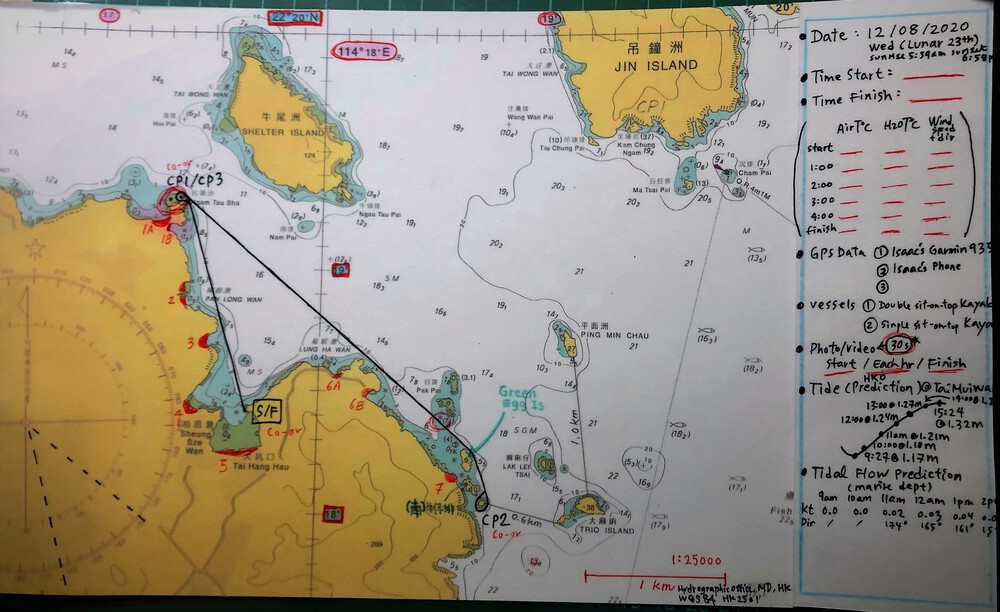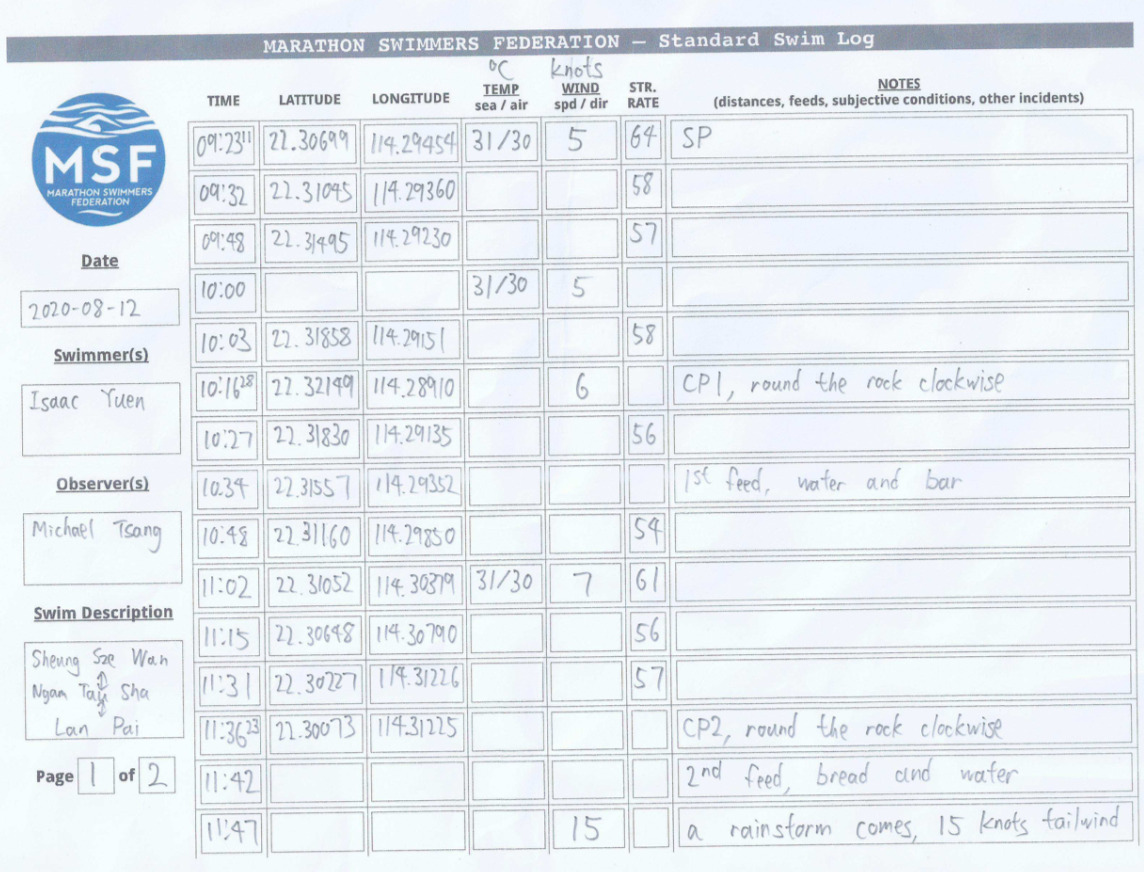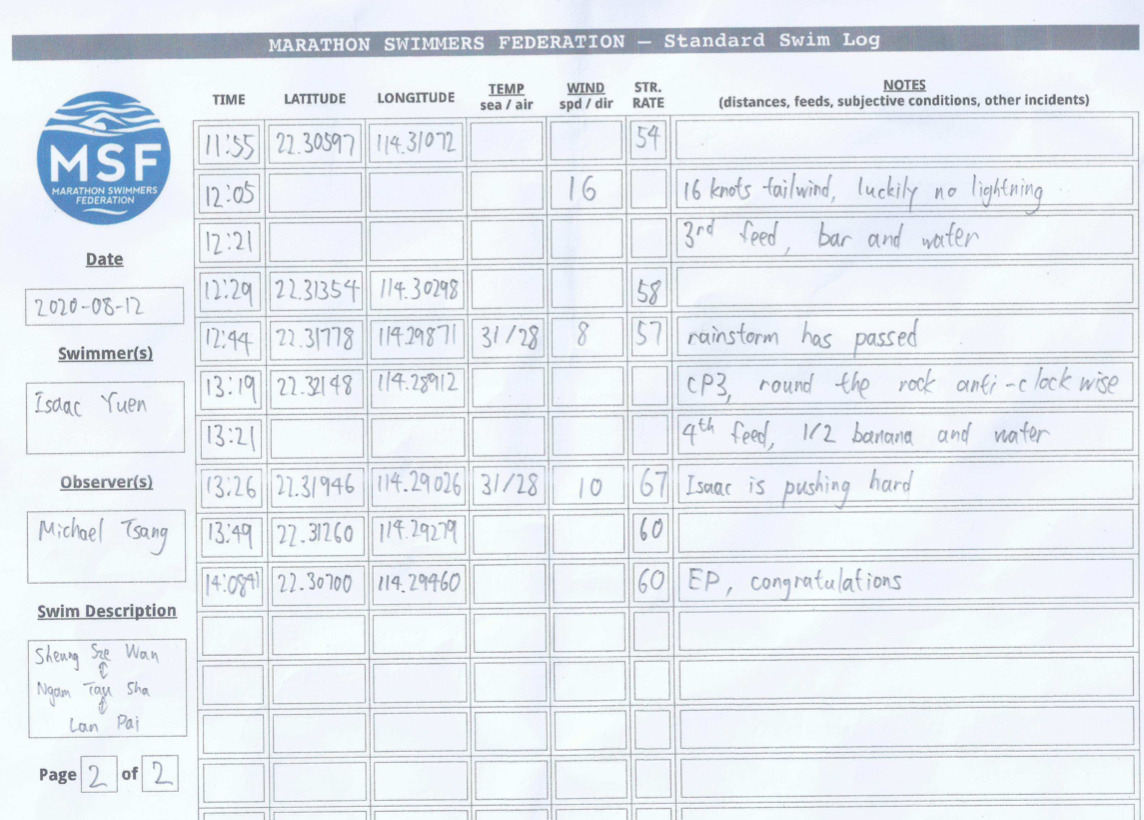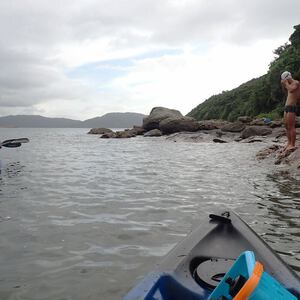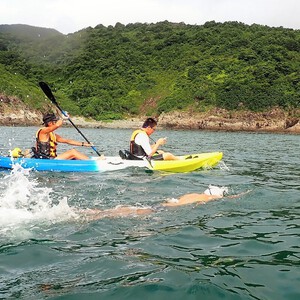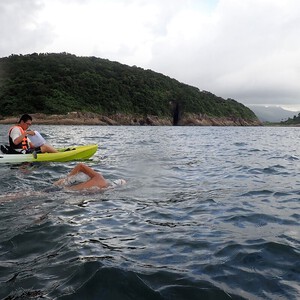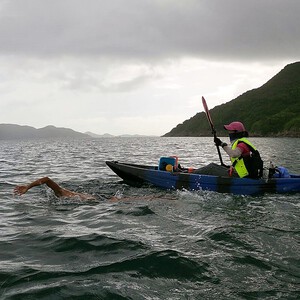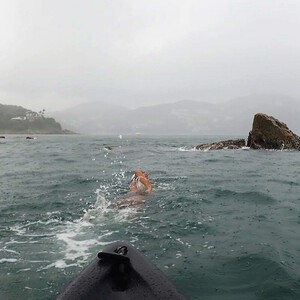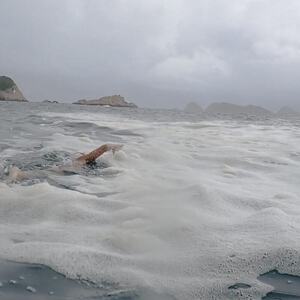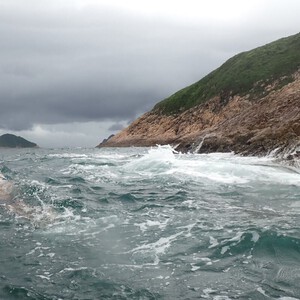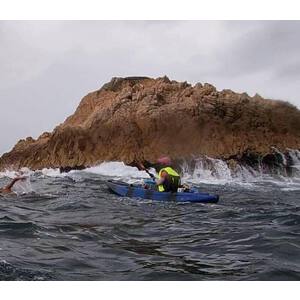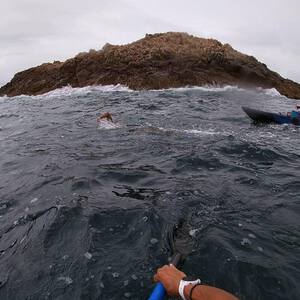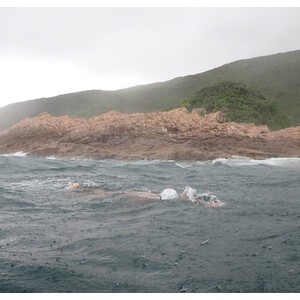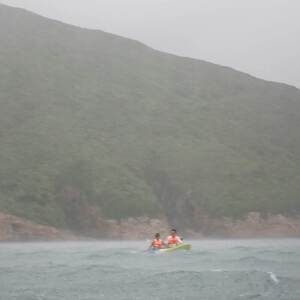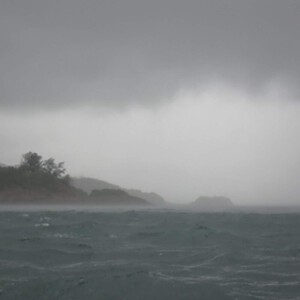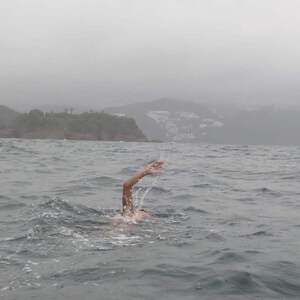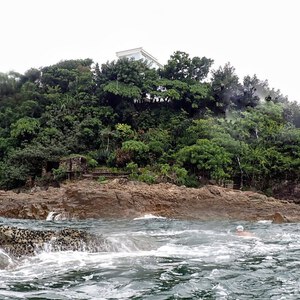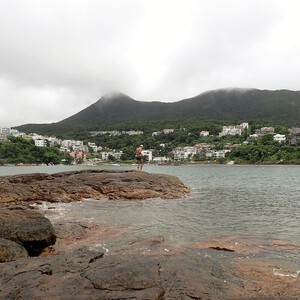Isaac Wan-ho Yuen - Port Shelter

Sheung Sze Wan - Ngam Tau Sha - Lan Pai loop
10.2 km (6.3 miles)
4 hours, 45 minutes on 12 August 2020
Observed and documented by Michael Chun Chi Tsang
First known swim of route

Contents
- Swimmer
- Support Personnel
- Swim Parameters
- Swim Data & GPS
- Observer Log
- Swimmer Statement
- Photos
- Video
- Weather Data
Swimmer
- Name: Isaac Wan-ho Yuen
- Gender: male
- Age on swim date: 36
- Nationality: Hong Kong
- Resides: Tseung Kwan O, Hong Kong
Support Personnel
- Alfair Lee - pilot
- Po Lam - crew
- Michael Tsang - observer
Swim escorted by two kayaks (one single and one double).

Swim Parameters
- Category: Solo, nonstop, unassisted.
- Rules: MSF Rules of Marathon Swimming, without exception or modification.
- Equipment used: MIZUNO polyester swim trunks, one swim cap, one pair of ear plugs, goggles.
Route Definition
Loop around Ngam Tau Sha (rock north of cape) and Lan Pai from Sheung Sze Wan
-
Start from Sheung Sze Wan, eastern cape of inner bay (22.30699,114.29454)
-
Ngam Tau Sha, clockwise around rock north of cape (22.32149,114.28910)
-
Lan Pai, clockwise around southernmost rock (22.30083,114.31225)
-
Ngam Tau Sha, anti-clockwise around rock north of cape (22.32149,114.28910)
-
Finish at Sheung Sze Wan, eastern cape of inner bay (22.30699,114.29454)
Minimum Route Distance: 10.2 km (6.3 miles) (map)
History
No known previous swims of this route
Swim Data
- Start: 12 August 2020, 09:23:11 (Asia/Hong_Kong, UTC+8).
- Finish: 12 August 2020, 14:08:41
- Elapsed: 4 hours, 45 minutes, 30 seconds.
Summary of Conditions
| Feature | Min | Max |
|---|---|---|
| Water Temp (C) | 31 | 31 |
| Air Temp (C) | 28 | 30 |
| Wind (knots) | 5 | 16 |
GPS Track
Trackpoint frequency: 5 minutes. Download raw data (CSV).
Speed Plot
Nutrition: Hourly: water + one of (bar, bread, banana)
Observer Log
Observer Report
by Michael Tsang
Background
Hong Kong has the environment for marathon swimming but the sport is not well-known here. There are few race opportunities and the participant figures, especially from locals, are not high. There are some solo challenges (including Hong Kong - Macau and round Hong Kong) but very few people have done them, and they are not affordable at all. Moreover, we have more population than New Zealand but we haven’t produced a single Channel swimmer yet.
I want to change this. After I raced Cold Half this year and signed up for a Channel slot next year, I want to build a self-sustaining marathon swimming community using only local resources, including swimmers, crews, coaches, observers, pilots, and boats. I want to make Hong Kong a marathon swimming destination in Asia with swims done according to the internationally-recognised standard of marathon swimming. Furthermore I also want to show to the world that we are capable to produce marathon swimmers right inside the 2755 km2 territory, with 60% being water. In order to do this, I will need to make a network of stakeholders, most importantly swimmers, crews and observers. These 3 roles are the absolute minimum required to undertake a swim according to the international standard. And also pilots, coaches and race organisers as well.
When we get enough people and have done a few swims, especially when we have got a few different local observers, we can form an association to independently ratify marathon swims done in Hong Kong waters, and organise annual races to further promote the sport. Before such an association is formed, we will try to self-plan some marathon swims first using the MSF documentation process, in order to familiarise with the international standard, and to establish legitimacy on ourselves. I am planning to do a few of such swims in the coming winter as part of my training to swim the Channel, and also to serve as a role model for other swimmers to follow as well. However, I don’t do marathon swimming in summer therefore I’m more than happy to help my fellow swimmers to do that if they want to swim when the weather is hot.
I met Isaac this year in March this year from a swim group. Most of the people in the group were not interested in swimming long distance (over 5 km) at all but Isaac was particularly interested when I introduced the idea of marathon swimming. He only started open water swimming this February since the pools were closed as a precaution of the coronavirus pandemic. When he started he only swam 3 km at a time but soon went up to 5 km with the group. He liked to explore different places by swimming. In May, under my encouragement he did an 8 km training swim with me exploring an island near his home. Since then he had swum in all different kind of conditions, from calm sea to BF 5, along the coast of Port Shelter. He did a 10 km training swim in July. He was ready to become a real marathon swimmer so it’s time to make it official, so I briefed him the MSF documentation process and the requirement for the route to be repeatable to be officially recognised. The purpose of this swim is not for personal challenge, but as an experimental swim as the first step to build the marathon swimming community mentioned in the previous paragraph. Therefore, he would like to do a route which is
-
just at the 10 km standard distance (to meet the official definition of marathon swimming, and as an idea for holding races at the standard distance in the future which currently don’t exist in Hong Kong apart from the national championship)
-
near Silverstrand and Clear Water Bay, his training place where he is most familiar with
-
along the coast with multiple landing spots such that safety-wise it is possible to use only kayak escort without motor support
-
start and end points easily accessible and with kayak rental nearby
The planning
Given the above points, the first is to identify a start / end point where kayak rental is nearby. Therefore we chose Sheung Sze Wan. There is kayak rental on the beach. Then we started to think of routes which meet the criteria. In the first few iterations I had to correct some of the Isaac’s plans, specifically on the part that the route must be “bounded”, and that we must clear the water with no running seawater behind at the start and finish. The beach is so shallow for an extended distance with hidden rocks at the bottom so it is not a desirable starting position. Therefore we chose a cape where the rock is climbable as the start point, such that we could legally remove Isaac’s shoes after he entered the water at the beach, and let Isaac do a short warm-up. Moreover, he would also want to avoid a drainage exit on the western shore of the Bay so we didn’t choose the safe beach to the north-west on the outer bay.
Isaac finally decided on the route which terminated at the eastern cape of Sheung Sze Wan, and rounded the rock north of Ngam Tau Sha and the southern most of Lan Pai to make the standard distance. After repeated measurement on Google Maps by me and also the crew making the bounds as tight as possible, the distance was to reported as 10.2 km, correct to the nearest 0.1 km.
This swim is safe to do and suitable for beginners. It will be a model suitable for introducing new swimmers into the sport of solo marathon swimming with minimal cost (the only direct cost here is kayak rental). The 10 km distance is manageable for a beginner. It is not near any shipping channel. There are not many motor boats. The current is manageable. There is no risk of hypothermia if it is done in May to November. There are no shark attacks for more than two decades. There are very few jellyfish and they are not harmful. The view on the route is interesting as well which is only possible to be seen in the water. The most prominent danger in the swim is the weather (typhoon or thunderstorm). It is important to check the weather forecast before starting and we have planned a few escape spots, including Little Palm Beach, Lobster Bay or the beach near Lan Pai where we can leave the water when the weather becomes bad.
The crew
Before Isaac started open water swimming, he was an ultra mountain runner. He assembled a two-person crew who were all ultra-endurance veterans, including another ultra mountain runner Po Lam and another ultra marathon runner Alfair Lee. They are all experienced paddlers as well. However, none of the swimmers and crews have any knowledge of marathon swimming before. I had to teach them the spirit and knowledge of marathon swimming, while they had taught me the knowledge of weather and sea as well.
We rented a 2-person sit-on-top and a 1-person sit-on-top. Alfair and I sat on the 2-person sit-on-top such that I could free my hands for recording the swim while Alfair was paddling, and Po sat on the 1-person sit-on-top. Theoretically one kayak was enough for a swim of such scale, but I was grateful that we used 2 kayaks because of the condition we had encountered, which is mentioned below. Alfair was the main pilot and photographer and Po was the feeder, but actually the roles were intermixed, except that Po remained as the sole feeder because all food and water were stored on the 1-person sit-on-top.
Pre-swim
Two days before the swim I suggested to postpone it for a week because the weather forecast suggested that there might be a thunderstorm on the day of swim. The weather a week afterwards would be sunny and less windy. (the swim was on a weekday and I had to take a leave from my office job, therefore if we decided early I could cancel the leave application) The only reasons we would call off the swim were typhoon or thunderstorm. However Isaac did not agree with my suggestion and suggested that we decide on the day. I deferred the final decision to the crew and the crew agreed with Isaac to decide on the day, because the swim had low risk, we had plenty of safety exits, and the cost to do the swim was low. That’s different from a channel swim.
There was a thunderstorm early morning around 04:00 on the swim day, but it was cleared as the sun rose. By 09:00 the weather was good for swimming. It was cloudy with a little rain, wind BF 2 - 3. However by reading the radar map, we were still concerned that a thunderstorm may come around noon. We decided to take the chance and go.
We rented the kayaks. I then inspected his gears which were all standard. As we loaded our stuff Isaac went into the water first and did a warm-up swim to the start point which was about 340 m away.
SP to CP1
I briefed Isaac on the 3 key rules (in Cantonese) he must adhere for the swim to be considered as valid:
-
he must not touch anything
-
he should swim alongside the kayaks, not behind them in a drafting position
-
he must clear the water completely at the start and finish
I instructed him to give an affirmative response if he agreed which he did, and entered the water. I announced the start time, which was 09:23:11. All are recorded in front of my action camera as part of the documentation process.
He predicted his speed to be 2.5 km/h which I felt it was realistic. Therefore he planned to round CP1 at 41 minutes, 1.7 km on the course. He reached CP1 at 10:16:28, 53 minutes from the start and 12 minutes off his plan.
CP1 to CP2
His initial feeding plan was to feed at 45 minutes, then every 30 minutes afterwards, but apparently he decided to feed every hour when doing the swim. He asked to crew to feed her when he swam for 1 hour, but that was already more than 1 hour into the swim. He did not have a good way of communication so it was really hard for the crew to tell him anything, but the crew were all ultra-endurance athletes and knew the sports physiology really well so the crew let Isaac to swim on and wait until Isaac requested a feed. The 1st feed was done at 10:34 with water and a bar.
Isaac swim well and there wasn’t really anything we had to worry on him. Our main worry remained the chance of thunderstorm. I live streamed his progress from time to time in a local open water swimming Facebook group. GPS live tracker was available as well. There were some other visitors in the area including other kayakers and also divers as the place is a hotspot in recent years, reported by television and magazines.
The route passed through the outside of Lan Pai as the inside is too shallow to swim. The swells brushing the rocks were spectacular but Isaac was not scared at all and rounded the rocks tightly. Although the wind was only BF 3, the landscape magnified the swell there.
Isaac reached CP2 at 11:36:23 at 5.1 km on the course, 2 hours and 13 minutes from the start, i.e. 13 minutes off his plan.
CP2 to CP3
Not long after CP2, Isaac took his 2nd feed, which was bread and water. At about 11:45 the weather worsened. The wind strengthened to 16 knots tail-wind and the rain became heavy. That’s the sign of a thunderstorm coming. Controlling the kayak became more difficult and we had to increase the spacing between us and the swimmer to prevent collision. The advantage of using 2 kayaks appeared because we could position one of ourselves to follow the swimmer closely without making hazardous maneover to switch position / sides under strong tailwind. We were worried that we would have to abandon the swim if a thunderstorm really come. We constantly checked the weather report to see if there were any lightnings nearby but fortunately it was mostly clear so we continued. The crew were really competent kayakers who made me stay safe under force 5 wind. The scariest moment was when the crew saw a lightning and we immediately checked the real-time thunderstorm forecast again. It still suggested that no lightning was predicted in the area, and based on the time difference between the lightning and thunder, the crew thought that it was not close enough to become an immediate risk, so we decided that was only an isolated occurance and continued on. It turned out that was really a single isolated occurance which hit Wan Chai, the central area of the skyscraper city of Hong Kong, 14 km from where we were. I prayed to God that no further lightning would come to let us continue our swim.
We survived the rainstorm which passed at about 12:15 and soon Isaac took his 3rd feed, bar and water. It was still raining but it was good for swimming now. It was better to be a swimmer than to be a kayaker at that moment as it was miserable to be on a kayak with rain dropping on my head and body, and I still have to perform my duty as the observer.
Isaac rounded CP3 at 8.5 km on the course at 13:19, 3:56 from start, 37 minutes off his plan.
CP3 to finish
The weather became nice again. The rainstorm made the air temperature dropped by 2 degrees from 30C to 28C. He took his 4th and final feed, water and half a banana, at 13:21, not long after rounding the check point. It seemed that he got a great push that his stroke rate once rocketed to 67, from 54-58 in the middle of his swim. He remained at about 60 strokes per minutes afterwards until he finished.
When he approached the finish, I filmed him using my action camera (for high-resolution recording) and my mobile phone (for live streaming) simultaneously. However my mobile phone ran out of battery just before he finished. That would lead to great trouble for my job if my mobile phone died in the middle of the swim. I didn’t bring a spare one as I thought that my phone, my watch, and the crew’s phone and watch which all had GPS recording enabled were enough for tracking, and I could use pencil and paper to record facts as well. However I forgot the fact that I needed to copy the coordinates from my phone to the log sheet and I didn’t realise beforehand that pencil-and-paper logging wouldn’t work in rain. As the only thing which I needed to record by the time my mobile phone died was finish, the action camera was enough to get it done. I instructed him to climb the rock and clear the water completely, then announced the finishing time, 14:08:41. He completed the 10.2 km swim in 4:45:30, about 45 minutes off his plan.
Post-swim
We took some photos together at the finish point and congratulated Isaac for his historical success. Afterwards, we paddled back to the beach while he swam back as a cool down. We were careful to get his shoes on before he landed, and that’s exactly the reason why we didn’t use the beach as the start / end point. We returned the kayaks and got back to Tseung Kwan O to have a meal afterwards, then it was time to get home for me to do my “homework”.
My experience as a new observer
There isn’t an established marathon swimming community in Hong Kong and hence there isn’t a network of observers. Even the existing marathon swimmers here do not have such experience. I asked Edie Hu who is one of the most experienced marathon swimmer living in Hong Kong (who has done a round Hong Kong swim), if she would become an observer and SHE thinks that I’m better suited to do the job because of my personality. Therefore I have decided to “get my hand dirty” myself as an experiment. That’s the main purpose of this swim. It is not possible for me to get formal training in this part of the world and I had to rely on the existing resources by the MSF, including the Rules of Marathon Swimming, old MSF documented swim reports, observer logs by various associations e.g. MSABC, and also a Facebook group called “Observer’s Notes” where people shared their experience, in particular a post by the founder of MSF, Evan Morrison, on 19th July when he was going to observe on a kayak.
My kit, as an observer, included 1 mobile phone at 80% battery (20% was consumed pre-swim as we communicated and checked the weather forecast), 2 probe thermometers, 1 anenometer, 2 sets of MSF observer log (1 cover page + 3 log sheets), a few pencils, and a Garmin watch in addition to standard paddling gear.
I thought I did well by video-recording the most important moments including the start, the finish, and the turns, and announcing the times and progress in the video clips. Moreover I also had spares of the materials I needed including the observer log sheets, video-recording devices, GPS tracking devices, thermometer, etc. (an anemometer was not an essential as it is possible to judge BF by eye)
The first mistake I did was forgetting to switch on the live tracking at the start. Therefore the live tracking was incomplete. However, I still had a complete track in my watch which I started just before the official start.
The second mistake I did was not realising that pencil-and-paper wouldn’t work when it was raining. My papers were stored in a waterproof bag which was only opened when I needed to write. Even that it didn’t work. Once the paper was taken out it was soaked at an instant and became unwriteable. I resorted to using my mobile phone. However because my mobile phone had to be wrapped in a waterproof bag, controlling it was so damn difficult with a layer of plastic on top of the screen, especially the dragging action required to switch between apps.
The third mistake I did was to think that 80% battery was enough for a 5-hour swim. It really drained fast when I use it to live-stream, to check weather forecast and maps, and to record the swim. In the latter part of the swim I had to reduce the frequency of live-streaming and to use my action camera to take videos instead.
This swim was a really good experiment for me, having completely no prior experience at all, to actually practice being an observer in a region of the world where marathon swimming is still not an established sport. It definitely helps me to build up my experience from a perspective other than as a swimmer, which can also help when I resume my marathon swimming in the winter. (I don’t swim for long distance in the summer because it is too hot - the water was 31C in this swim.)
Conclusion
Isaac has become a marathon swimmer. However this is not that important.
Although the swim itself is not spectacular at all, it serves a few important milestones in the history of marathon swimming in Hong Kong.
-
it is the first known solo marathon swim in Hong Kong pioneered by a local swimmer who is not an expat, and by a swimmer who has no previous marathon swimming experience overseas.
-
it is the first solo marathon swim in Hong Kong done using the MSF documented swim process since it has been established in 2013.
-
it is the first known solo marathon swim in Hong Kong which is truly accessible to the public without requiring expensive boat escort and paperworks to cross shipping lanes.
-
it is the second known solo marathon swim in Hong Kong which is done by a Hongkonger (with the first being Alex Fong’s Hong Kong Island circumnavigation in 2019).
This swim will serve as a role model where a team with “inexperienced” swimmer, (Isaac only started OWS this year and his longest swim was only 3 km 5 months ago), crew (who did not have any knowledge of marathon swimming at all beforehand) and observer (who only started marathon swimming 1 year ago with no solo experience at all) can succesfully undertake a solo marathon swim in a region of the world where the sport is not well-known, with careful planning utilising existing MSF resources and the knowledge transferred from other endurance sports such as mountaineering, marathon running, coasteering, etc on a safe beginner-friendly 10 km route.
The swim itself is not the most important. The impact which it can bring to the society, to the development of the sport of marathon swimming, and the foundation it establishes for future swimmer, make this swim worthwhile.
Swimmer Statement
by Isaac Yuen
What inspired you to do this swim?
I have always been a runner. Swimming only used to be my tool for cross-training to promote muscle recovery. I just started open water swimming in February 2020 when swimming pools were closed due to COVID-19. Before that, I never underwent any intensive training in swimming.
My new swimming journey started when I joined the local swimming group “Open Water Swimmers of Hong Kong” which guided novice swimmers around the south of Hong Kong Island every weekend. Each swim route was around 2 to 3km long. Since the first swimming session, I fell in love with ocean swimming even though I was never placed in the fastest group. Similar to trail running, both are indicative of how humans can connect with nature.
During my journey, I met the two key people that inspired me to start this project, Mr. Michael Tsang and Mr. Alfair Lee. Mr. Michael Tsang is an ambitious swimmer who aims to accomplish long-distance swimming challenges like swimming across the English Channel and Mr. Alfair Lee is a profound paddler.
Unlike running, conquering a marathon in the world of swimming is not easy. First, there are only a few races in our region and most of them are not up to the 10km standard. Second, courses of the races held by Federation Internationale De Natation (FINA) are usually in repeated loop forms and the level of difficulty is too high for recreational swimmers. Therefore, I came up with the idea to create a repeatable course of 10km in length where the route stays away from major marine traffic yet in close proximity to public transportation and water sports centers to simplify logistics. I wish to set up guidelines for beginners to complete their first swim marathon in sheltered waters with a low cost.
This project also serves as a blueprint for further development of the local swimming community by establishing guidelines to sanction and promote marathon swims done in Hong Kong waters.
Please describe how you planned for the swim.
Port Shelter of Sai Kung is one of the underrated spots for open water events. I live nearby and get access to the beaches for training. My first long-distance swim was in May 2020 when I did an 8km swim around Shelter Island. Since then, I did regular 4 to 5km exploratory swims to islands in this area and gather ideas on how to design a suitable course. Finally, I came up with this course to use Sheung Sze Wan as the starting point where the kayak hiring center is located and pass by the landmark “Green Egg Island (Lan Pai)”. The whole course is close enough to the shore that using only kayak support is possible.
Endurance sport is not something new to me. I have over 50 marathon/ultra-marathon/trail running finishers under my belt. I swam all but three days in July to ramp up my yardage, reaching a month total of 115km. Entered to the tapering stage, I swam on alternative days but increased the distance of each section to 5km. I felt I was in my best shape within the past six months before the challenge.
How did the swim go, generally? Did you face any unanticipated challenges?
The climate of Hong Kong is sub-tropical. The months May to August are hot and humid with occasional showers and thunderstorms. Temperatures often exceed 31C in the daytime with high humidity. Few days prior to the swim, we noticed the weather was unstable. There was the possibility of a thunderstorm. We once considered postponing the swim but finally decided to move the start time to the morning, hoping to finish before the rainstorm comes from the south.
This is only a marathon-distance challenge hence I kept the nutrition plan simple. I relied on bread, bananas and nutrition bars, and asked the crew to provide me the food every 30 to 45 minutes. I split the course into six sections by locations (Little Palm - 1.7km, Lobster Bay - 3.5km and Green Egg Island - 5km). Unlike other swims, I do not have a GPS watch or a timer to track my pace. The plan was to swim in a consistent pace and go all out when I entered the last section at 8.3km.
The swim started well for the first section. I took my first feeding after 1 hour in and stayed focus till I reached Lobster Bay. Being semi-submerged in water, it was difficult to gain knowledge of the situation outside. Only later did I notice that the weather started to deteriorate and rain droplets were hitting my back. The waves and current became stronger and hindered me from moving forward. I skipped the second feeding and wanted to carry the momentum to the south turning point. The swells were strong and I experienced one of the most turbulent waters I had ever faced when swimming around the island rock.
I understood the swim could be terminated anytime when the thunderstorm arrived. Therefore my aim was to return to the shelter area for the safety of me and my team. I could not navigate well under choppy conditions and realized that I was off-track when I almost reached another island called Pak Pai. Fortunately, the weather permitted us to re-enter Lobster Bay where there were multiple swim withdrawal locations and the water was sheltered. Still, the visibility was low and I headed towards the wrong direction several times. When I finally saw Little Palm Peninsula, I was confident the swim could be completed, and I evaluated how much effort was needed to push in the last stretch. When High Junk Peak appeared again, it was a home run to return to Sheung Sze Wan. My first standard swim marathon was accomplished.
What do you think after completing the challenge?
Whilst a distance of 10km is far from the definition of a swim challenge, it carries a few significances:
- I come from a non-swimming background and only started open water swimming half year ago. I want to demonstrate that marathon swim is not an elite sport but is accessible to everyone.
- Hong Kong has been quite successful as a trail running hub in Asia. With a long coastline and over 350 islands, it is a perfect place for developing ocean swims. We wish to work with MSF guidelines to provide resources for open water swim challenges and events.
- The whole team, including the swimmers, observers and crews are all new to their roles. We do not fear making mistakes. This project sets out a roadmap to coordinate swim races and provides a platform to endorse long-distance swims.
“That’s one small step for a man, one giant leap for mankind.”
Photos
Click to enlarge.
Video
Weather Data
- Temperature (Windy)
- Temperature (Hong Kong Observatory)
- Wind (Windy)
- Wind (HKO)
- Swell
- Tide (Marine Department)
- Tide (HKO)
